Anselm Baumann
geboren 1958 in Freiburg, lebt in Frankfurt am Main
Auster, 2025
Grösse inkl. Kiste ca. 40 x 25 x 10 cm
Porzellan, Glasur und Perlmutt Lüster
Auflage: 12 + 3 AP, signiert auf Holzkiste
980 € inkl. 7 % USt.
© Anselm Baumann und Provinz
︎ Anfrage / request
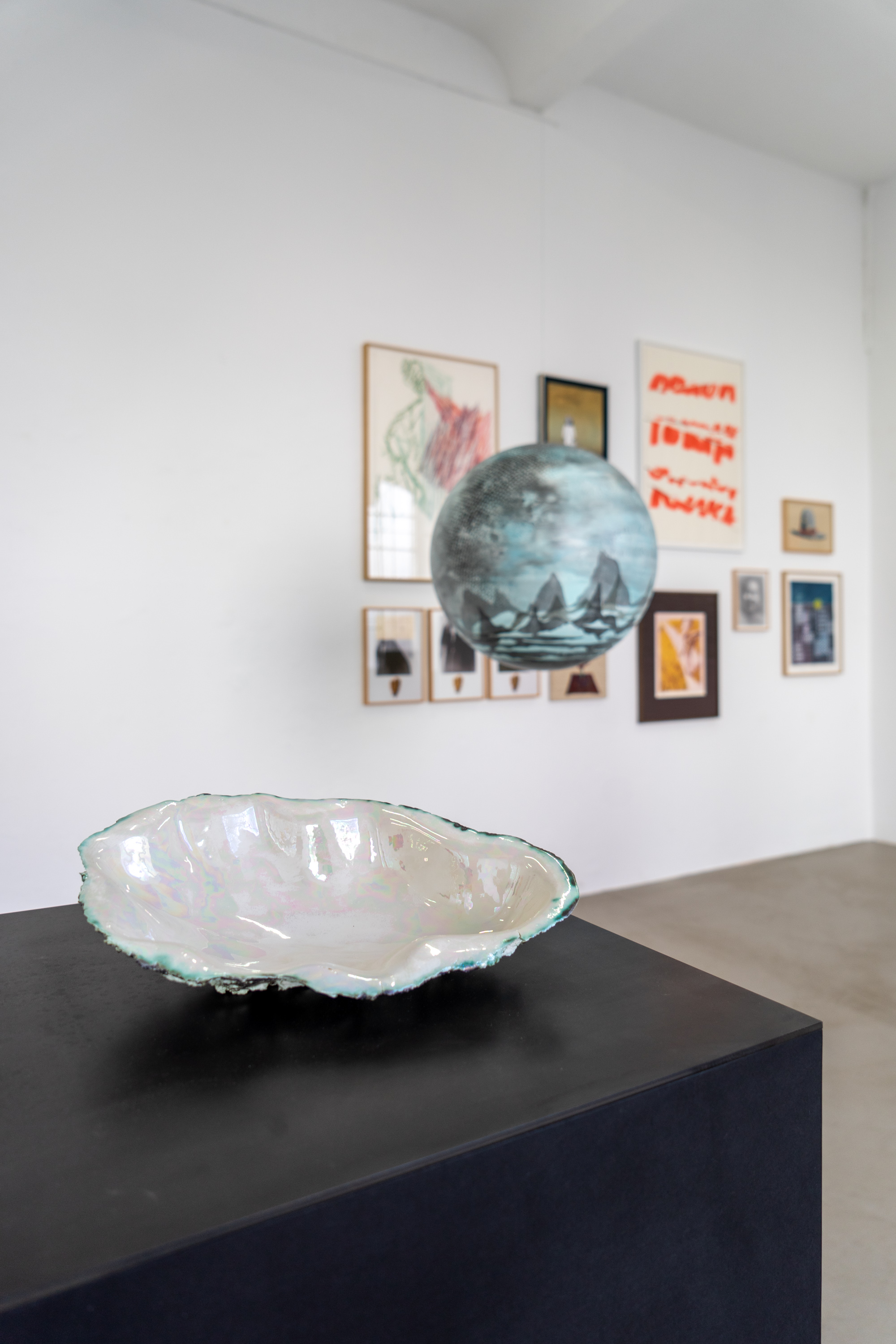
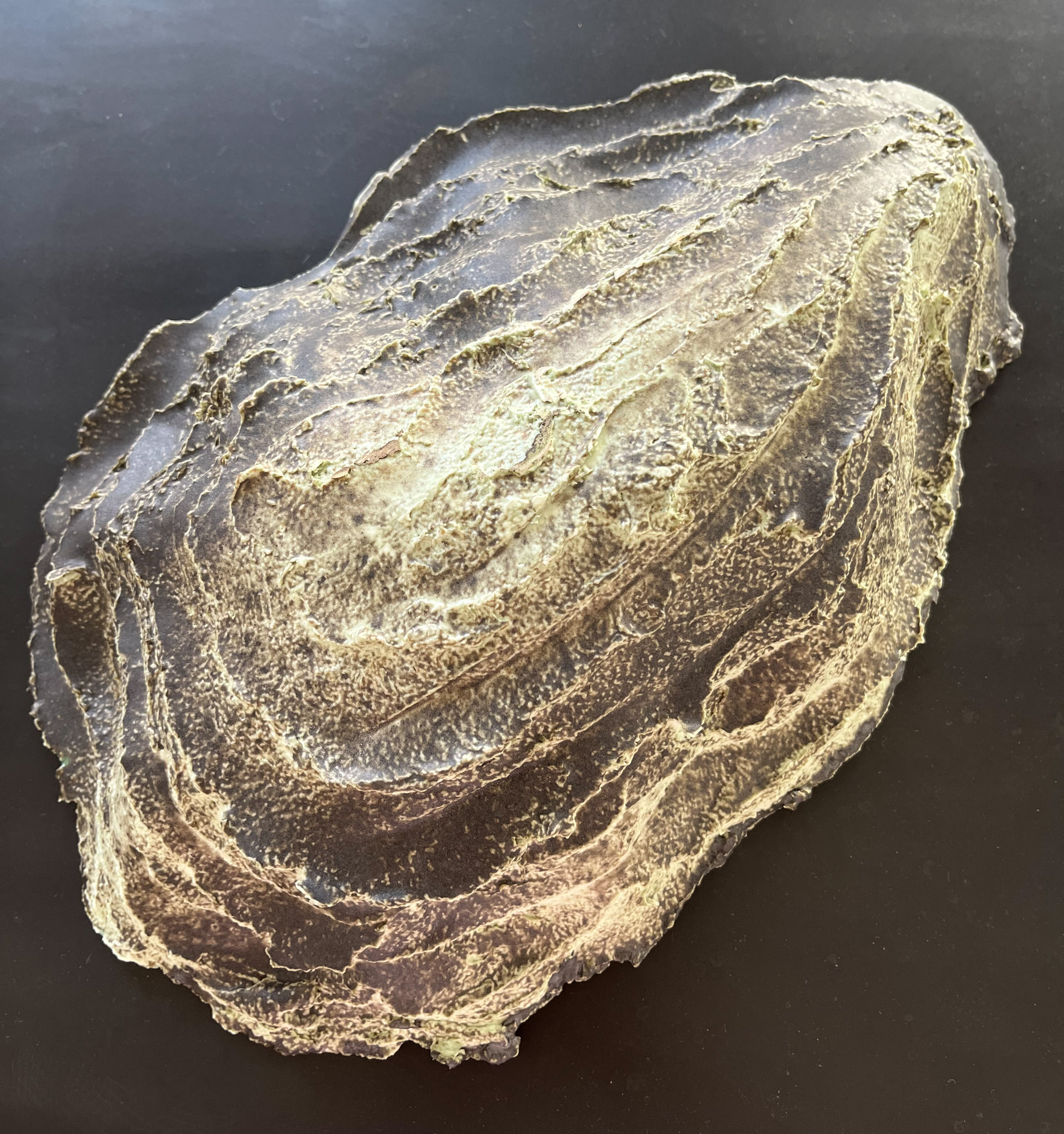
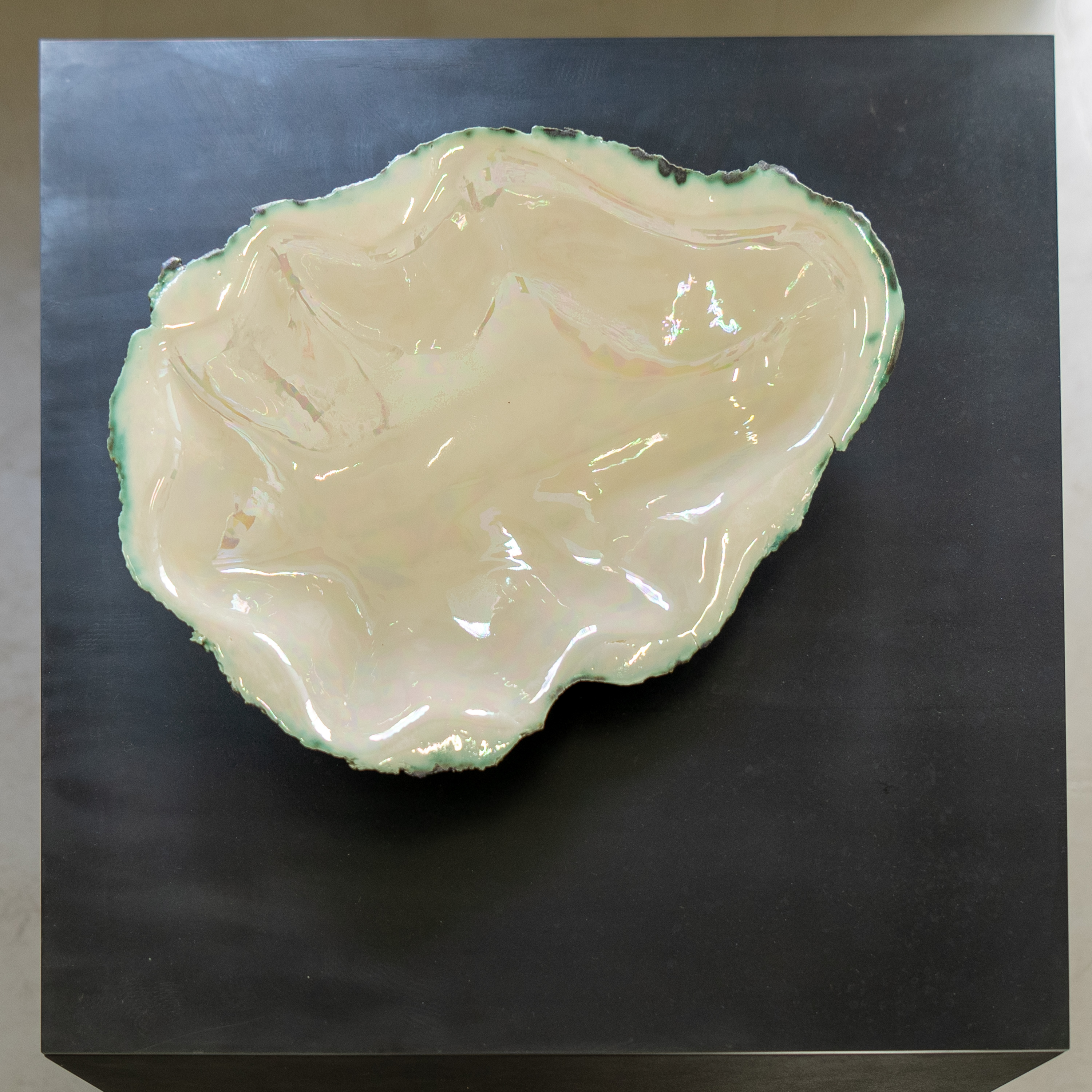
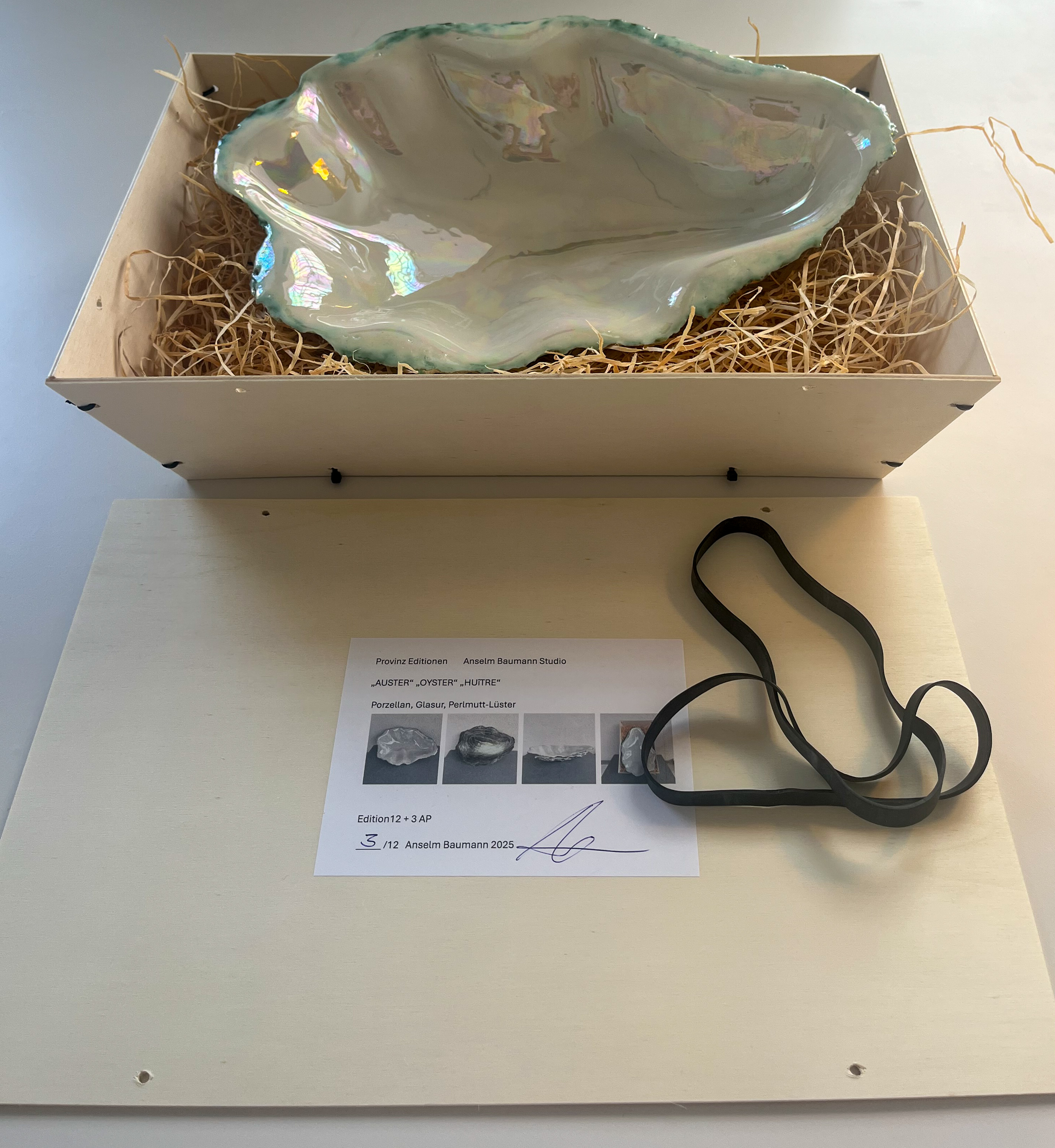
Anselm Baumann interessieren Oberflächen, Strukturen und das Experimentieren mit unterschiedlichen Materialien und Farben. Beton, Gips, Keramik, Porzellan, Kunststoff und Pigmente sind die Werkstoffe, die ihn dabei besonders faszinieren und von deren Materialeigenschaften er sich leiten läßt. Daraus schafft er wandfüllende, abstrakte Reliefs, die man sich förmlich erlaufen muss oder großformatige Skulpturen z.B. in Form fassartiger Vasen mit ungewöhnlichen Blumenbouquets. Eine wellenartige Struktur zieht sich wie ein roter Faden durch viele diese Arbeiten. Das die Oberfläche füllende, alles verbindende Muster stammt von Wellpappe, wie sie etwa zum Schutz von Weinflaschen verwendet wird. Häufig geben Alltagsgegenstände den Anlass für seine Formfindungen. In seiner jüngsten Werkgruppe, so auch in unserer Edition, sind es jedoch Austern und deren zwei “Gesichter“, die ihn hier herausforderten. Äußerlich ist die Auster unscheinbar, dunkel und verkrustet, innerlich von kostbarem, perlmuttfarbigem Glanz. Sie steht für kulinarischen Luxus und hat gleichzeitig eine neu entdeckte ökologischen Rolle. Seit Jahrhunderten gilt sie als Delikatesse, ein Symbol für Genuss, Überfluss und gesellschaftliches Prestige. Doch sie ist nicht nur Nahrungsmittel, sondern reinigt das Wasser, schafft Riffstrukturen für neue Lebensräume und wird weltweit von der Wissenschaft als Architektin gesunder Meere neu entdeckt. Anselm Baumanns übergroße Versionen aus Porzellan, Glasur und Perlmutt Lüster sind eine echte Hommage an diese bemerkenswerte, grandiose Muschel.
Anselm Baumann hat im Anschluss an seine Lehre als Bildhauer an der traditionsreichen Münsterbauhütte als Gast an der Kunstakademie in Karlsruhe studiert. Er war Stipendiat an der Akademie Schloss Solitude in Stuttgart und gründete das Unternehmen „Ostpool“, das für Künstler*innen wie Tobias Rehberger und Anne Imhoff produziert.
Anselm Baumanns Werke sind in bedeutenden privaten und öffentlichen Sammlungen vertreten, u.a. im Museum Pfalzgalerie, Kaiserslautern, Museum für Neue Kunst, Freiburg, Kunstmuseum Stuttgart, der Sammlung der Deutschen Bank, Frankfurt am Main, Kunstsammlung der Mobiliar, Bern
Anselm Baumann is interested in surfaces, structures, and experimenting with different materials and colors. Concrete, plaster, ceramics, porcelain, plastic, and pigments are the materials that particularly fascinate him, and whose properties guide him. From these, he creates wall-filling, abstract reliefs that one practically has to walk towards, or large-format sculptures, for example, in the form of barrel-like vases with unusual floral bouquets. A wave-like structure runs like a common thread through many of these works. The pattern that fills the surface and connects everything comes from corrugated cardboard, such as that used to protect wine bottles. Everyday objects often provide the impetus for his formative inventions. In his most recent group of works, including those in our edition, however, it is oysters and their two "faces" that challenge him. Outwardly, the oyster is inconspicuous, dark, and encrusted, but inside it has a precious, mother-of-pearl luster. It represents culinary luxury and, at the same time, has a newly discovered ecological role. For centuries, it has been considered a delicacy, a symbol of pleasure, abundance, and social prestige. Yet it is not only a food source; it purifies the water, creates reef structures for new habitats, and is being rediscovered by scientists around the world as the architect of healthy oceans. Anselm Baumann's oversized versions made of porcelain, glaze, and mother-of-pearl luster are a true homage to this remarkable, magnificent shell.
Following his apprenticeship as a sculptor at the venerable Münsterbauhütte (Cathedral Workshop), Anselm Baumann studied as a guest at the Karlsruhe Art Academy. He held a scholarship at the Akademie Schloss Solitude in Stuttgart and founded the company "Ostpool," which produces works for artists such as Tobias Rehberger and Anne Imhoff.
Anselm Baumann's works are represented in important private and public collections, including the Museum Pfalzgalerie, Kaiserslautern; the Museum für Neue Kunst, Freiburg; the Kunstmuseum Stuttgart; and the Deutsche Bank Collection, Frankfurt am Main, collection Mobiliar, Bern
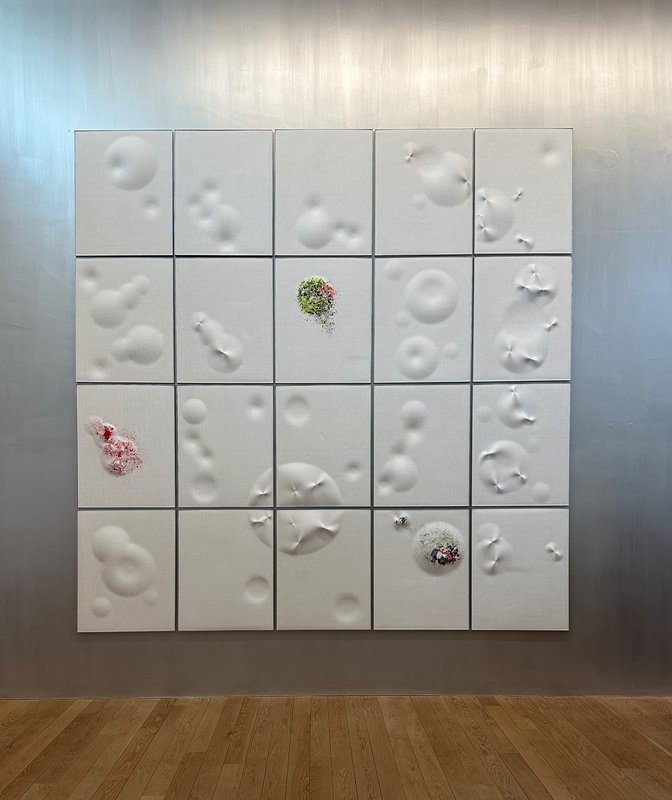
Anselm Baumann: eccentric molecules premium, 2023
98 × 75 × 5 cm, 520 × 320 × 5 cm, 20-teilige Reliefarbeit, Poly-Plaster und Aluminium © Anselm Baumann

Anselm Baumann: eccentric molecules premium, 2023, detail
 Anselm Baumann: Schöne Aussicht, 2024 Material: Porzellan, Glasur, Polymer-Gips, Aluminium, Ausstellung „Backstage-Engelberg“ 2024 Kuratiert von Dorothea Strauss © backstage engelberg
Anselm Baumann: Schöne Aussicht, 2024 Material: Porzellan, Glasur, Polymer-Gips, Aluminium, Ausstellung „Backstage-Engelberg“ 2024 Kuratiert von Dorothea Strauss © backstage engelberg